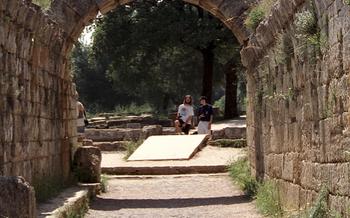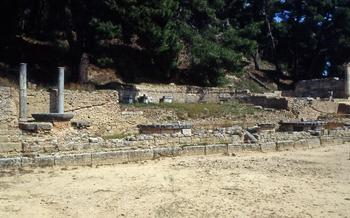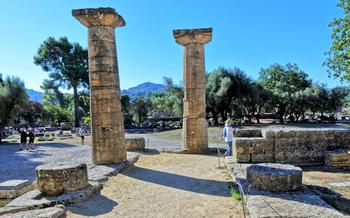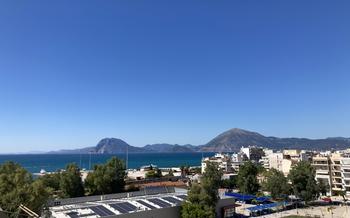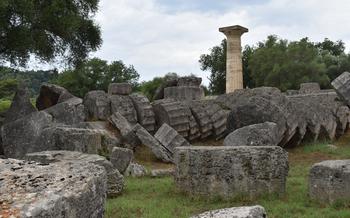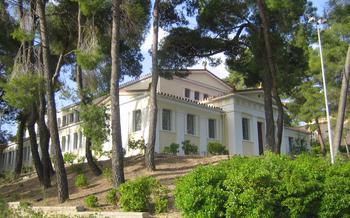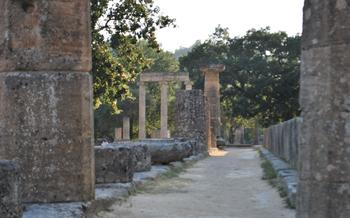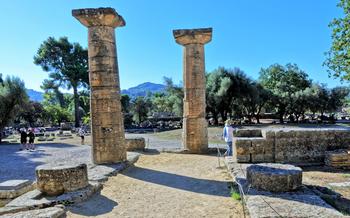
Archaeological Museum of Pyrgos
- The Archaeological Museum of Pyrgos: A Hidden Gem in Olympia
- The History and Significance of the Museum
- The Building and Architecture of the Museum
- The Collection and Exhibits of the Museum
- The Statue of Hermes and the Praxiteles Connection
- The Roman Mosaics: A Glimpse into Ancient Life
- The Theater Masks: Expressions of Ancient Drama
- The Terracotta Figurines: A Link to Ancient Religion
- The Everyday Objects: A Window into Ancient Life
- Interactive Exhibits and Educational Programs
- Temporary Exhibitions and Special Events
- Accessibility and Facilities
- Location and Transportation
- Hours, Admission, and Contact Information
- Insider Tip: Exploring the Local Area
The Archaeological Museum of Pyrgos: A Hidden Gem in Olympia
Nestled in the heart of Olympia, the Archaeological Museum of Pyrgos unveils the rich history and cultural heritage of this ancient land. This hidden gem houses a treasure trove of artifacts, sculptures, and everyday objects that transport visitors back in time to the glorious era of Ancient Greece. As you step through the doors of this neoclassical building, prepare to be captivated by the stories etched in stone, pottery, and bronze, whispering tales of a civilization that shaped the course of Western history.
The History and Significance of the Museum
The Archaeological Museum of Pyrgos stands as a testament to the rich history and cultural heritage of Olympia, a site deeply entwined with the origins of the Olympic Games. In ancient times, Olympia served as a sanctuary and a place of pilgrimage, drawing visitors from across the Greek world to witness the sacred games and pay homage to the gods. Pyrgos, located in the vicinity of Olympia, played a crucial role in supporting the activities of the sanctuary and accommodating the influx of visitors.
The establishment of the Archaeological Museum of Pyrgos was a direct result of the significant excavations conducted in Olympia during the 19th century. These excavations unearthed a wealth of artifacts and relics, shedding light on the history, culture, and religious practices of ancient Olympia. The establishment of the museum in 1962 provided a dedicated space to house and display these invaluable findings, ensuring their preservation and accessibility to the public.
The museum's collection serves as a valuable resource for scholars and researchers studying ancient Greek history and culture. It contributes to the broader understanding of the Olympic Games, the religious significance of Olympia, and the artistic and cultural achievements of the ancient Greeks. By preserving and showcasing these artifacts, the Archaeological Museum of Pyrgos plays a vital role in safeguarding and promoting Greece's rich cultural heritage.
The Building and Architecture of the Museum
The Archaeological Museum of Pyrgos stands as a testament to the architectural grandeur of the Neoclassical period. Its imposing facade, adorned with intricate details and symmetrical lines, draws visitors' eyes and hints at the treasures within. The building's elegant proportions and harmonious design reflect the architectural principles that shaped many significant structures in Greece during the 19th century.
One of the distinguishing features of the museum is its unique entrance, flanked by two imposing columns that support a grand pediment. This architectural element, reminiscent of ancient Greek temples, adds a sense of grandeur and historical significance to the museum's exterior. The pediment is adorned with intricate carvings, showcasing the artistry and craftsmanship that went into the building's construction.
As a symbol of cultural heritage, the Archaeological Museum of Pyrgos has undergone extensive restoration and preservation efforts to maintain its architectural integrity and showcase its historical significance. These efforts have ensured that the building remains a testament to the enduring legacy of ancient Greek architecture and a fitting home for the treasures it houses.
The Collection and Exhibits of the Museum
The Archaeological Museum of Pyrgos houses a diverse collection of artifacts from the ancient city of Olympia and its surrounding area. These artifacts provide a glimpse into the rich history, culture, and daily life of the region.
Sculptures, Pottery, and Jewelry
The museum's collection includes a number of impressive sculptures, ranging from small figurines to larger-than-life statues. These sculptures depict a variety of subjects, including gods and goddesses, heroes and athletes, and scenes from mythology. The museum also displays a collection of pottery, from simple utilitarian vessels to elaborately decorated vases. These vases often feature scenes from daily life or mythology, providing valuable insights into the artistic and cultural traditions of ancient Greece.
Everyday Objects and Tools
In addition to sculptures and pottery, the museum also houses a collection of everyday objects and tools. These objects provide a fascinating glimpse into the daily lives of the ancient Greeks. Visitors can see agricultural implements, tools for weaving and woodworking, and household items such as cooking utensils and oil lamps. These objects offer a tangible connection to the past, allowing visitors to imagine what life was like in ancient Olympia.
The collection of artifacts at the Archaeological Museum of Pyrgos is not only aesthetically pleasing but also historically significant. These artifacts provide valuable insights into the culture and daily life of ancient Greece, making the museum a must-visit destination for anyone interested in history and archaeology.
The Statue of Hermes and the Praxiteles Connection
In 1877, during excavations near the Temple of Hera in Olympia, a remarkable discovery was made that would captivate the world of archaeology and art history: the statue of Hermes carrying the infant Dionysus. The statue, crafted from gleaming white marble, exuded an aura of grace and elegance that hinted at its extraordinary significance.
Upon closer examination, scholars recognized the unmistakable style of Praxiteles, one of the most celebrated sculptors of ancient Greece. The statue's harmonious proportions, the delicate rendering of the drapery, and the lifelike depiction of the figures left no doubt that it was a masterpiece by the renowned artist.
The statue of Hermes is not only a stunning work of art but also holds immense historical and cultural significance. Its discovery shed light on Praxiteles's artistic techniques and his influence on the development of Greek sculpture. Moreover, it provided valuable insights into the religious beliefs and practices of ancient Olympia, where the statue was likely displayed as an offering to the gods.
Today, the statue of Hermes stands as one of the highlights of the Archaeological Museum of Pyrgos. Its presence in the museum serves as a testament to the rich artistic heritage of Olympia and the enduring legacy of Praxiteles, whose works continue to inspire and captivate audiences worldwide.
The Roman Mosaics: A Glimpse into Ancient Life
In the heart of the Archaeological Museum of Pyrgos, a collection of stunning Roman mosaics unveils a vibrant window into ancient life. These intricate artworks, carefully preserved and displayed, transport visitors to a bygone era, where mythology and artistry intertwined.
Discovered during excavations in the ancient city of Elis, these mosaics once adorned the floors of wealthy Roman villas, adding a touch of opulence and grandeur to their living spaces. The intricate designs and vibrant colors depict a variety of scenes, from mythological battles to pastoral landscapes, offering a glimpse into the beliefs, values, and daily lives of the ancient Romans.
The mosaics employ a technique known as opus tessellatum, where small, multicolored tesserae (tiles) are meticulously arranged to create intricate patterns and figures. The level of detail and artistry is truly remarkable, showcasing the exceptional craftsmanship of ancient mosaicists.
One particularly captivating mosaic depicts the abduction of Persephone, the daughter of the goddess Demeter, by the god Hades, who takes her to the underworld. The expressions of grief and longing on the faces of Demeter and Persephone are vividly portrayed, evoking a sense of drama and emotion.
These Roman mosaics not only serve as exquisite works of art but also provide valuable insights into the cultural and religious beliefs of the ancient Romans. They offer a glimpse into their mythology, their reverence for the gods, and their fascination with the natural world.
As you admire these ancient masterpieces, let your imagination soar, and transport yourself back in time to the opulent villas of ancient Elis, where these mosaics once added a touch of magic and wonder to everyday life.
The Theater Masks: Expressions of Ancient Drama
The Archaeological Museum of Pyrgos boasts an impressive collection of ancient theater masks, offering visitors a glimpse into the world of ancient Greek drama. These masks, crafted from various materials such as clay, wood, and leather, represent a diverse range of characters and emotions.
The collection features tragic masks depicting various expressions of grief, anger, and despair, as well as comic masks portraying humor and joy. The masks are adorned with intricate details and vibrant colors, showcasing the artistry and craftsmanship of ancient Greek mask makers.
Beyond their aesthetic value, these masks provide insights into the performance practices and storytelling traditions of ancient Greek theater. They allowed actors to embody different characters and convey emotions to the audience even from a distance.
The variety of masks on display highlights the rich repertoire of ancient Greek drama, from tragedies to comedies and satyr plays. Each mask tells a story, offering a glimpse into the vibrant world of ancient Greek theater.
The Terracotta Figurines: A Link to Ancient Religion
Among the many artifacts on display at the Archaeological Museum of Pyrgos, the terracotta figurines hold a special significance, offering a glimpse into the religious beliefs and practices of ancient Greece. These small, hand-crafted figurines, typically made of clay, depict a wide variety of subjects, including deities, animals, and humans. Their importance lies in their connection to ancient religious rituals and their ability to provide insights into the beliefs and practices of the ancient Greeks.
The figurines were often used as votive offerings, presented to the gods and goddesses in temples and sanctuaries as a form of devotion or gratitude. They were believed to represent the individual making the offering or to symbolize a specific prayer or request. The variety of deities depicted in the figurines reflects the diverse pantheon of ancient Greek gods, including Zeus, Hera, Apollo, Artemis, and Aphrodite, each associated with different aspects of life and nature.
Animals were also commonly represented in terracotta figurines, particularly horses, bulls, and rams. These animals were often associated with specific deities or were considered sacred in their own right. For instance, the horse was associated with the god Poseidon, while the bull was sacred to Zeus.
Human figurines, often depicting worshippers or specific individuals, were also prevalent. These figurines may have been used to represent the individuals themselves or to serve as substitutes for their presence in religious ceremonies.
The terracotta figurines on display at the Archaeological Museum of Pyrgos offer a tangible connection to the religious beliefs and practices of ancient Greece. They provide insights into the hopes, fears, and aspirations of the people who created and used them, shedding light on the religious landscape of ancient Olympia and the surrounding region.
The Everyday Objects: A Window into Ancient Life
The Archaeological Museum of Pyrgos also houses a remarkable collection of everyday objects that provide a fascinating glimpse into the daily lives of the ancient Greeks. These ordinary items, often overlooked in historical narratives, offer valuable insights into the material culture and domestic practices of this remarkable civilization.
From simple tools used in agriculture and craftsmanship to household items such as cooking utensils, pottery, and furniture, these artifacts bring to life the practical aspects of ancient Greek existence. Visitors can marvel at the ingenuity and craftsmanship of the ancient artisans who created these functional objects, often adorned with intricate designs and motifs that reflect their aesthetic sensibilities.
These everyday objects also shed light on the social and economic structures of ancient Greece. The presence of imported goods, for example, hints at the existence of trade networks that connected different regions of the Mediterranean. The variety of tools and implements used in various crafts, from weaving to metalworking, speaks to the specialization of labor and the development of a diverse economy.
By examining these ordinary objects, visitors to the Archaeological Museum of Pyrgos gain a deeper understanding of the daily realities of life in ancient Greece. These artifacts humanize the distant past, allowing us to connect with the people who lived, worked, and created in this remarkable civilization over two millennia ago.
Interactive Exhibits and Educational Programs
The Archaeological Museum of Pyrgos takes a forward-looking approach to enhancing the visitor experience by incorporating various interactive exhibits and educational programs. These innovative features cater to different learning styles and make history and archaeology more accessible to all.
Digital Displays and Touchscreens: Interactive digital displays and touchscreens are scattered throughout the museum, providing detailed information about the exhibits, their historical context, and their significance. Visitors can zoom in on artifacts, view 3D models, and explore timelines and maps.
Audio Guides and Guided Tours: For a more in-depth experience, visitors can rent audio guides that offer commentary and explanations for each section of the museum. Guided tours led by knowledgeable museum staff are also available, providing insights into the history and significance of the collection.
Workshops and Educational Activities: The museum regularly organizes educational workshops and activities for children and families. These hands-on sessions allow participants to engage with ancient history and culture through art projects, storytelling, and interactive games.
By incorporating these interactive elements, the Archaeological Museum of Pyrgos fosters a dynamic and engaging learning environment that appeals to visitors of all ages and backgrounds.
Temporary Exhibitions and Special Events
The Archaeological Museum of Pyrgos is not just a static repository of ancient artifacts; it is also a dynamic cultural venue that hosts temporary exhibitions and special events throughout the year. These exhibitions often focus on specific themes or periods of ancient Greek history and culture, showcasing new discoveries, research findings, and collaborations with other institutions.
Temporary exhibitions provide an opportunity for visitors to see rare and unique artifacts that may not be on permanent display, offering fresh perspectives and insights into the ancient world. They also contribute to the museum's mission of promoting research, education, and cultural exchange.
In addition to exhibitions, the museum organizes special events such as lectures, workshops, and educational programs for children and adults. These events provide a platform for scholars, artists, and experts to share their knowledge and engage with the public, fostering a deeper understanding of ancient Greek civilization.
By hosting temporary exhibitions and special events, the Archaeological Museum of Pyrgos remains a vibrant and engaging institution that offers visitors a diverse and enriching experience, constantly renewing its appeal and relevance to the local community and international visitors alike.
Accessibility and Facilities
The Archaeological Museum of Pyrgos is committed to ensuring an accessible and enjoyable experience for all visitors, regardless of physical limitations or disabilities. Accessibility features include wheelchair ramps and elevators, providing easy navigation throughout the museum's premises. Audio guides in multiple languages are available to enhance the visitor experience, allowing everyone to engage with the museum's rich collection. For further assistance, visitors can reach out to the museum's friendly staff, who are always ready to provide support and information.
Additionally, the museum offers a cafeteria where visitors can take a break and enjoy refreshments. A gift shop is also available, providing a variety of souvenirs and educational materials related to the museum's exhibits. Visitors can store their belongings in the cloakroom, ensuring a hassle-free exploration of the museum.
Location and Transportation
The Archaeological Museum of Pyrgos enjoys a strategic location in the heart of the Peloponnese, nestled amidst ancient ruins and scenic landscapes. Its proximity to Ancient Olympia, a mere 20-minute drive away, makes it an ideal starting point for exploring this iconic UNESCO World Heritage Site. The museum is also within easy reach of other notable attractions in the region, such as the picturesque beaches of Kyllini, the medieval town of Mystras, and the ancient city of Corinth.
Transportation to the museum is convenient and hassle-free. Public buses provide regular service between Pyrgos and Ancient Olympia, with stops conveniently located near the museum. For those arriving by car, ample parking is available in the vicinity of the museum.
To make the most of your visit, consider renting a car to explore the surrounding area at your own pace. The scenic roads offer breathtaking views of the Peloponnesian countryside, dotted with vineyards, olive groves, and charming villages. Whether you're a history buff, a nature enthusiast, or simply seeking relaxation, the region surrounding the Archaeological Museum of Pyrgos promises an unforgettable experience.
Hours, Admission, and Contact Information
The Archaeological Museum of Pyrgos is open to the public from Tuesday to Sunday, with extended hours during the summer season. Admission fees are nominal, with reduced rates for students, seniors, and families. Guided tours in English and other languages are available upon request, providing a deeper insight into the museum's collection and history. For further inquiries, reservations, or to arrange a guided tour, visitors can contact the museum directly through their website or via email. Online ticketing and reservations are also available for a convenient and hassle-free visit.
Insider Tip: Exploring the Local Area
Beyond the museum, the region of Olympia offers a wealth of attractions and experiences that will enrich your visit.
-
Immerse yourself in the history of the ancient Olympic Games at the Archaeological Museum of Olympia, showcasing artifacts and sculptures from the sacred site.
-
For a taste of traditional Greek cuisine, indulge in delicious home-cooked meals at local tavernas, where you can savor the flavors of the region.
-
Explore the picturesque village of Olympia, with its charming streets, traditional architecture, and vibrant atmosphere.
-
Discover the natural beauty of the surrounding area by embarking on hikes through the lush forests, marveling at the stunning views of the Alfeios River and the Ionian Sea.
-
Treat yourself to a relaxing stay at one of the many hotels in Olympia, offering a range of options to suit every budget and preference.
Embrace the opportunity to explore the local area and create lasting memories of your journey to Olympia.
